MMC3000
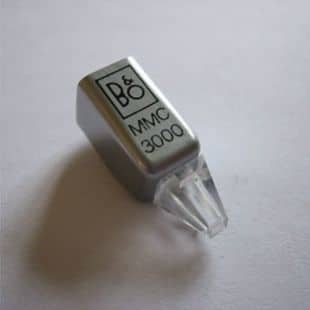
The MMC3000 was the basic model in the all new range of cartridges.
It was designed for use with the lower end of the range such as the Beogram 1100 and Beocenter 1800 and 3600. It has a spherical diamond stylus.

The MMC3000 was the basic model in the all new range of cartridges.
It was designed for use with the lower end of the range such as the Beogram 1100 and Beocenter 1800 and 3600. It has a spherical diamond stylus.
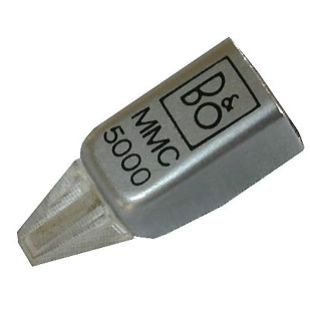
This was the cartridge specified for the Beogram 3400 and had a Shibata profile diamond. This is quite a rare cartridge to find these days as many 3400s did not have the CD4 decoder fitted and hence did not require this cartridge..
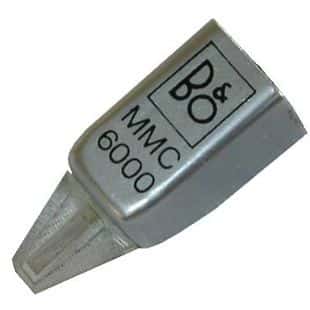
Bang & Olufsen’s (then) most accomplished pickup cartridge was fitted to Beogram 6000.
The MMC principle was adapted to track 4-channel records: both Quadradiscs and SQ. MMC 6000 would track both mono and stereo records with the utmost fidelity. It was designed for record-players with tangential arms. The stylus was the Pramanik diamond, named after its inventor: engineer S K Pramanik from Bang & Olufsen’s Laboratories.
The diamond’s radii were 7 um/2 x 50 um. It was a refinement of the elliptical shape, rather like the shape of the cutter-head, and enabled greater contact with the undulations of the record groove. The cantilever was made of berylium – a material which is harder yet lighter than popularly-used aluminium. Effective tip mass was 0.22 mg. Compliance was higher than 30×10-6 cm/dyne. Recommended- stylus pressure was 1g. The total frequency range was 20-45.000 Hz.
In the audible range: 20-15.000 Hz there is less than 1.5 dB variation and in the inaudible range 20,000-45,000 Hz where the carrier frequencies lie, the pick-up fulfils RCA/JVC’s specifications for a Class A discrete 4-channel pick-up cartridge. Each cartridge is an integrated, individually calibrated unit. The stylus unit is not separately replaceable since it is part of the integrated unit. An individual frequency response curve traced on a Bruel & Kjaer level recorder and a complete Calibration Card were enclosed with every MMC 6000 sold.

This top-operated receiver was not just exciting in appearance, it was also designed to facilitate operational comfort.
Primary controls were easily accessible, while the rarely used secondary regulators were concealed. The large tuning scale had calibrations in MHz and channel numbers. Tuning accurately to a desired station was child’s play because the large transparent slider was also provided with three small thumbwheels which assisted fine tuning.
Your three favourite stations could be pre-set by individual controls which were safely concealed beneath a sliding panel on the upper right hand side of the set. Subsequent programme selection was by easy pushbutton. The use of Field Effect Transistors (FETs) and Automatic Frequency Control (AFC) ensured optimum FM reception and compensated for weak signal conditions during tuning.
The amplifier’s power output was 2×15 watts RMS or 40 watts total music. Ambiophonic reproduction could also be obtained simply by connecting four loudspeakers, 2 in front and 2 to the side. In this way you could obtain an ‘extended’ stereo reproduction, a more realistic recreation of musical experiences recorded, for example, in a concert hall, because ambience or room information were included as well as direct musical information. There was a push button, the ‘ambio filter’, by which you could damp or reduce the highest tones (treble) reproduced in the side speakers. This was sometimes desired since the reflected sound which is reproduced in the side speakers is mostly mid-range tones. By damping high tones in the side speakers you could obtain a more natural sound reproduction.
Balance regulation was solved in a unique way in Beomaster 1001. Volume was controlled by two sliders, one for right and the other for left channel. The two sliders cold be operated together with one grip or separately, so that the balance between the channels could be adjusted as desired. The receiver’s slim, compact cabinet allowed several playing positions. Mounted on a wall (with special mounting bracket), slightly slanted (by special supports fitted to its base), or the traditional horizontal position. There were connections for record-player (switchable between high and low ohms), tape-recorder, headphone and four loudspeakers. A light indicated when the receiver was switched on, when the FM programme source was in use and whether a programme was in mono or stereo.
Receivers and amplifiers with the ambio function were products which, apart from stereo, could also reproduce the ambience or sound information of a room. Ambient information was included on most stereo vinyl recordings but could not be reproduced by a sound system with two loudspeakers or an ordinary stereo amplifier. Bang & Olufsen systems with the ambio function had facilities which electronically subtracted the difference signal (i.e. the difference between left and right channels) which contained ambient information. This information was fed into two extra loudspeakers which were placed as side speakers in a room. Ambiophony was an extension of stereo reproduction and enhanced the sense of realism. It could be used with nearly all stereo programme materials.
FM room aerial
In order to receive FM programmes, an FM aerial must be connected to the Beomaster 1001. Within a certain radius of the transmitter you could use the Bang & Olufsen FM room aerial, type 8902010. This aerial was easily fitted and the telescopic elements could be pulled out and positioned favourably.
Wall mounting
If desired, the Beomaster 1001 could be mounted on a wall by means of a special bracket. type 8920243. The bracket was screwed onto the wall and the receiver easily hung in position.
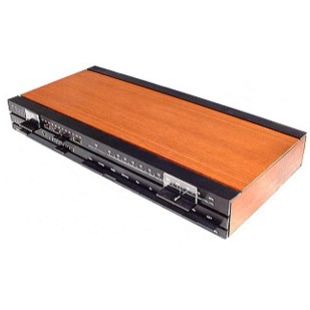
Beomaster 1100 in 1977/78 was a powerful, sensitive and compact unit incorporating an FM tuner and stereo amplifier.
The tuner had facilities for presetting four favourite stations, and once these had been permanently tuned, the programme of your choice could be instantly selected just by pressing a button. There was also a large slider and scale for manual tuning. An AFC (Automatic Frequency Control) switch was provided to help capture weak stations and keep them correctly tuned.
The amplifier section had a power output of 2 x 22 watts RMS with minimal distortion – less than 0,3% at full power. There were connections for two pairs of loudspeakers, a record player, headphones and a tape or cassette recorder (for which A monitoring facilities were also included).
Beomaster 1100 could be made up as part of the Beosystem 1100, together with other compatible Bang & Olufsen products.
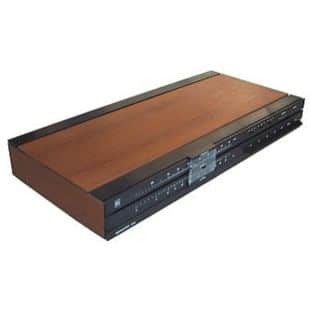
Beomaster 1700 Type 2607 was a tuner designed to complement BeoLab 1700 amplifier.
“This title might suggest a paradox to many readers. And in a way you are right. But there is a reason why Bang & Olufsen has separated this otherwise perfectly integrated high-fidelity system. The combination possibilities in Beosystem 1700 are so numerous that for many people the entire system is unnecessary. The essential part of the system is BeoLab 1700: a 2 x 20 watts RMS amplifier with ambiophonic stereo facilities.
The tuner, Beomaster 1700, the cassette-recorder, Beocord 1700 and the record player, Beogram 2000 cover nearly all existing programme sources for the reproduction of music. Beovox 2702 loudspeakers complete the system. Beovox 1702 are recommended as side speakers for ambiophony, if this extra sound experience is desired. Now it is up to you to put your ideal Beosystem 1700 together. ” – 1974 Catalogue
Beomaster 1700 was a highly sensitive FM tuner with manual tuning on the entire scale, plus 3 pre-set stations. The FM scale covered the 87.5-104 MHz range, channel numbers were clearly written on the scale to aid easy tuning. There were pre-set facilities for P1, P2 and P3 so that subsequent programme selection was by easy push buttons. An illuminated indicator made tuning easy and the AFC (automatic frequency control) facility assisted fine tuning. The tuner was highly sensitive and distortion was less than 0.5 %. Frequency range was 20-15.000 Hz, the same as that transmitted from FM stations. Field effect transistors, integrated circuits and ceramic filters were used in Beomaster 1700.
This tuner offered choice in the range but don’t buy this imagining that you will be getting something akin to a Beomaster 5000. Comparing the two is invidious as the cost was far different and the contents of the Beomaster 1700 case were much simpler. It did allow use with devices like the Beocord 2400 which had a built in amplifier but the tuner would be a very low cost choice.

Beomaster 2000 at the time of its introduction in 1974 was an all-new model. The FM/AM stereo receiver was constructed to facilitate simple, logical operation.
Five FM stations could be pre-selected. Secondary controls which are not used daily were hidden under sliding panels. For example, the five FM pre-selectors, controls for AFC and muting (silent tuning), were discretely hidden away from view until such time as you needed them.
The construction of the stereo decoder was based upon a phase lock system which ensured constant high separation of channels. Manual tuning on the large FM/AM tuning scale was by means of a plain circular disc which was flush-mounted into the control panel. The tuning scale was illuminated and a light indicator assisted accurate tuning on an FM station. The AM section, (long and medium waves), had ceramic filters which enabled good separation between stations.
The newly developed automatic volume control effectively achieved a good balance between the weak and the strong AM stations. Darlington output circuits in the amplifier section produced 2 x 40 watts RMS or 150 watts total music, with less than 0.1 % harmonic distortion. One of the TAPE connections facilitated AB monitoring. It was possible to copy from one tape recorder to the other without having to fiddle with cables and sockets. There were sockets for two pairs of loudspeakers and for stereo headphones.
Two tape recorders could be connected and could be switched to enable copies of tapes to be made, in either direction. The set was housed in a large flat cabinet of a similar style to the Beomaster 1200 range, though the ‘slide rule’ pointer was replaced with a conventional dial, operated by a large flush aluminium wheel. A flywheel beneath this made manual tuning very smooth and the large diameter of the control, coupled with the now familiar dual light tuning indicator, also made it very accurate.
To complement slim appearance of the cabinet, a wire prop at the rear could be folded down, tipping the whole machine forward slightly enabling the controls and lights to be viewed more easily.
FM room aerial
Within a certain radius of the FM transmitter you could use the Bang & Olufsen room aerial, type 8902010. The aerial was easily fitted and the telescopic elements positioned as required.
This is one of the forgotten Beomasters. It utilised an amplifier design that would prove to be the most successful for B&O. It formed the basis for all the great amplifiers to follow in the range. Wonderful control of bass and plenty of reserve.
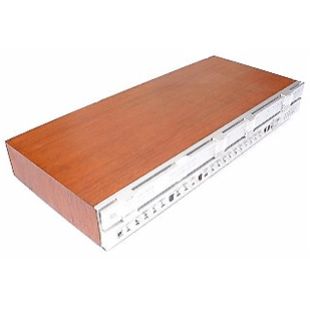
Beomaster 3000-2 was a solid state FM stereo receiver. The receiver was the kind of product you wanted to both look and to listen to.
It delivered 2 x 40 watts RMS at 30-30.000 Hz and whose distortion was less than 0.5%. With additions to the receiver like Beogram 3000, a fully automatic record player whose operating functions were executed by one master control, and two Beovox 3800 pressure chamber loudspeakers, Beosystem 3000 formed a complete high-fidelity system which deserved to be included in serious evaluations by those who felt that a quality hi-fi system must be chosen in separate units.
The unit was a high fidelity stereo amplifier in which emphasis was placed on specifications, frequency correction and connection facilities. The LOUDNESS feature permitted switching between an objective or a subjective linear reproduction and the LOW and EH filter controls gave a sharper regulation of frequencies, in addition to the normal bass and treble controls. The LOW filter helped reduce rumble resulting from a poor or defective record. At 80Hz its slope was 12dB per octave. There were sockets and push buttons for two pairs of loudspeakers. The headphone socket was situated on the front of the receiver. The tape connection facilitated AB monitoring and there were two record-player inputs: a high and a low impedance. All input sockets could be adjusted from the receiver’s base so that all signals had the same sound level. This was an extra convenience because one needed not adjust the volume control on the amplifier when it was switched between programme sources. The FM section had six pre-set stations. A light indicator assisted accurate tuning and the indicator registered the signal strength of a station. The FM section was extremely sensitive (better than 1.4 uV, I.E.C.) and harmonic distortion was only 0.4%. Field effect transistors, ceramic filters and integrated circuits were used.
In 1972 the Museum of Modern Art in New York (MoMA) chose seven Bang & Olufsen products designed by Jacob Jensen to be included in their Design Collection as representing excellent examples of the Museum’s criteria for quality and historical importance; design, in fact, which had influenced the twentieth century. Beomaster 3000 was one of those seven products. Two years’ previously Beomaster 3000 won the iF Design Award.
Beomaster 3000-2 was introduced in 1972. Both units could be used as part of Beosystem 3000. The two models were visually indistinguishable except for the model number, but the Beomaster 3000-2 contained a few minor technical improvements. The effect of these was not visually or aurally evident; the improvements were seen as Bang & Olufsen’s desire at that time to offer the customer the best components and aural experience.
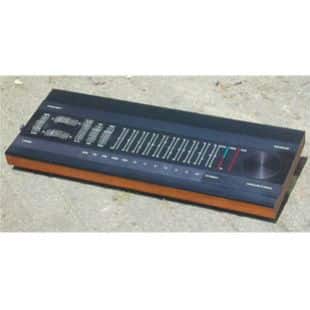
Beomaster 3400 Type 2802 was a 4-channel receiver whose out put was stated as 4 x 20W or 2 x 30W, depending on how it was configured.
This receiver was a development of the Beomaster 2000 but as well as being quadraphonic, was FM only. The tuning scale was extremely unusual being a series of vertical scales rather than a single horizontal one. Despite the huge length thus provided, it still only read up to 104!
It was designed to be partnered by the Beogram 3400 which could provide the correct 4 channel input as well as the stereo cassette player, the Beocord 2200. S45 or P45 speakers made up the rest of the system.

Beomaster 901, by 1977/78 was Bang & Olufsen’s simplest receiver. However, no compromises were made on quality. The tuner section covered Long, Medium and FM wavebands with a very high standard of reception quality.
Tuning was by ways of a slider which moved smoothly along a clearly marked scale. An illuminated indicator and AFC (Automatic Frequency Control) circuit helped to make tuning easy and accurate. The MONO control button disconnected the built-in stereo decoder when correct stereo reception was impaired by bad weather conditions or other interference.
Beomaster 901’s large tuning scale had tuning facilities for FM, Long and Medium wave stations. The tuning slider had small thumbwheels to aid fine tuning. AFC locked the receiver to the desired station
The stereo amplifier had a powerful output of 2 x 20 watts RMS and special Darlington-coupled transistors in the output stages kept distortion to a minimum – less than 0,3% at full power. There were connections for two pairs of loudspeakers and a pair of headphones. Sockets were also provided for the connection of a tape recorder, a record-player and AM and FM aerials. Easy-to-use sliders controlled volume, balance, bass and treble and there were slim push-buttons for selecting waveband or tape or record input.
FM room aerial
In order to receive FM programmes, an FM aerial must be connected to the Beomaster 1001. Within a certain radius of the transmitter you could use the Bang & Olufsen FM room aerial, type 8902010. This aerial was easily fitted and the telescopic elements could be pulled out and positioned favourably.
Beomaster 901 could be made up as part of the Beosystem 901 including the the Beogram 1102 record player, Beocord 1101 cassette deck and 2 Beovox Uni-Phase S25 or P30 loudspeakers.